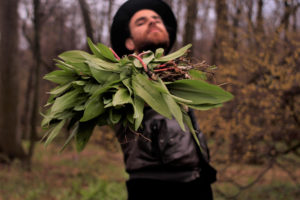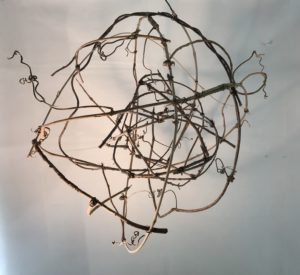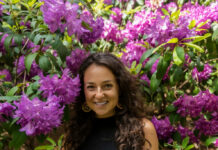
Amid winter in North America, celebrating new plant growth seems unfathomable, but Tu B’Shevat, the Jewish celebration and “New Year” for trees, celebrated on Jan. 16-17 this year, approaches anyway.
Even in a period where so many trees lie fallow, area Jews still believe there’s plenty to celebrate, reflecting in the host of events being held over the holiday.
“The day you plant a tree is not the day you enjoy and eat the fruit,” said Zalman Wircberg, director of the Old City Jewish Arts Center.
During another COVID-era Tu B’Shevat, just because there are fewer opportunities to spend time outside of one’s house or with loved ones doesn’t mean internal growth isn’t occurring, Wircberg said.
Themes of internal sowing and change are reflected in OCJAC’s two Tu B’Shevat exhibits by Elkins Park-based artist Diana Taflin Myers on display until Jan. 20: “Branching Out: A Celebration of Trees” and “SOS:2020.”
Myers’ collections of more than 20 pieces are composed mostly of natural materials and found objects, such as twigs, branches and wooden puzzle pieces.
“Branching Out” was inspired by the Tu B’Shevat celebrations she experienced while living in Israel in the ’60s and ’70s.
“It’s not only work with branches, but it was also an opportunity for me to branch out — challenge myself in the art to see how many things I could do with branches and trees and natural pieces,” Myers said.
“SOS: 2020,” displayed alongside “Branching Out” is an examination of the themes from the early days of the pandemic: isolation, racial strife and preservation of democracy.
In one piece, “Sheltering in Place,” Myers uses chess pieces, small toys and teeth separated into little boxes to represent families in isolation. Her other pieces, “Life Reimagined” and “I Can’t Breathe,” address the political climate of early summer 2020.
“Those are pieces really meant to be a tool for social change for people to see and hopefully, react,” Myers said.
The Artist’s Reception for the exhibits is on Jan. 16 from 2-4 p.m. at OCJAC, 119 N. Third St., Philadelphia.
For those looking to find meaning in the holiday, The Weitzman National Museum of American Jewish History is hosting a set of programs designed to celebrate the “mystical” nature of the holiday, Weitzman Director of Public Programs Dan Samuels said.
The Weitzman will host a tree tour of West Laurel Hill Cemetery, led by Arboretum Manager Aaron Greenberg, on Jan. 16 at 1 p.m.
“It’s a pretty cold time of year — maybe not everyone’s favorite time to go outside, but there’s actually a lot going on inside of trees around here this time of year,” Samuels said. “What does it mean for it to be a new year for the trees?”
The tour will focus on the hidden biological processes trees undergo during the winter, as well as the history of the arboretum on which the trees are located.

Beyond the hidden growth trees undergo during Tu B’Shevat is also a hidden mystical meaning, observed in a Tu B’Shevat seder held in partnership with the Rising Song Institute.
The Musical Tu B’Shevat Seder, led by Rebekka Goldsmith, Batya Levine, Jessie Reagen Mann and Rabbi Micah Shapiro, will be held virtually on Jan. 16 at 8 p.m.
“Tree time is slow time,” Goldsmith said. “There are changes and growth [that is] not even perceptible to the human eye, and yet over time, we see big changes happen. For me, when we slow down, and we open up with sound, sound is the same thing. There’s change that happens when we sing together.”
The seder, similar to the Passover seder, features a meditation through the four “worlds” outlined in Kabbalistic texts, Goldsmith said. Each world, marked by changes in the type of wine drunk and fruits and nuts consumed, represent physicality, thought, spirituality and emotionality.
“Any ritual is always greater than the sum of its parts,” Goldsmith said. “All this can be explained, but it’s really magic what happens when you get into it.”
Information on the Weitzman’s events can be found at nmajh.org.
Below are additional area
Tu B’Shevat events:
Alliance Community Reboot Tu B’Shevat Winter Garden
Jan. 17, noon; virtual
Join ACRe gardener Ahron Moeller and team on Facebook Premiere for an experiment in cultivating wild ramps and preparing the Passover garden for the new Alliance Historic Model Farm.
Shalem Farm Virtual Seder
Jan. 17, 2 p.m.; virtual
Join Shalem Farm’s Yitzchak Glasman for a seder that includes blessing and tasting various fruits and wine in order to celebrate the new year of the tree.
Tribe 12 Breathe In & Branch Out: A Guided Meditation/Reflection
Jan. 17, 6:30 p.m.; virtual
This Zoom meditation for LGBTQ+ Jews in their 20s and 30s allows attendees to reflect on the ideas of privilege and oppression at the intersection of Tu B’Shevat and Martin Luther King Jr. Day.
Beth Sholom Congregation Virtual Israel Tour
Jan. 17, 7:30 p.m.; virtual
Take a virtual tour of Israel to gain a better understanding of the country’s green energy sources, bird migration and initiatives to plant new trees.
Congregation Kol Ami Virtual Seder
Jan. 19, 7 p.m.; virtual
This Zoom seder will feature the three types of fruits eaten on this holiday. The grocery list and details for the seder can be found by emailing
[email protected].
[email protected]; 215-832-0741






